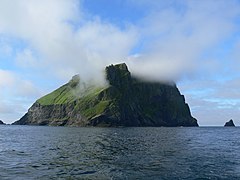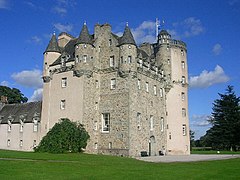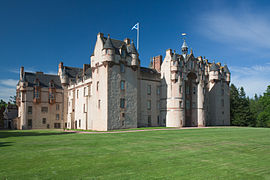National Trust for Scotland
The National Trust for Scotland (actually The National Trust for Scotland for Places of Historic Interest or Natural Beauty , short: NTS; Scottish Gaelic : Urras Nàiseanta na h-Alba ) is a private, non-profit foundation for the preservation and care of cultural and Natural Landmarks in Scotland . It is the Scottish counterpart to the National Trust , which looks after similar properties in England , Wales and Northern Ireland .
history
The National Trust for Scotland was founded in Glasgow in 1931. Sir John Stirling Maxwell met in 1930 with some acquaintances with whom he had been involved in the Association for the Protection of Rural Scotland (APRS) in the past . Disappointed that Scotland was not involved in the activities of the National Trust , which was founded in 1895 , the assembly decided to set up a separate organization for these matters in Scotland. The APRS provided start-up assistance by providing staff and office space. In November 1930, was a board under the leadership of the 8th Duke of Atholl , but the official was entered in the register of associations until May 1, 1931. John Stirling Maxwell served as first vice president of the new organization and gave her to Crookston Castle the first property. In the following years, other objects were quickly added, including a coastal strip called a castle on the Isle of Mull and the Royal Burgh of Culross (both 1932), a section of the Antonine Wall (1934), the ruins of the Cistercian monastery Balmerino in Fife , land in the valley by Glen Coe (1935 and 1936) and the Bannockburn battlefield . The number of members and the number of properties managed by the NTS has risen continuously over the years.
A severe financial crisis in 2009 forced the Foundation to lay off employees and sell its prestigious listed headquarters in Charlotte Square, Edinburgh . The organization then commissioned an appraisal, as a result of which, among other things, restructuring of the management floor and administration was carried out and, for the first time in the history of the NTS, a complete and central register of all its properties was created.
organization
The highest body of the NTS is a 13-person board of trustees , headed by a chairman and his deputy. The foundation employs over 1200 people, 540 of whom work full-time (as of February 2015). They are spread across different departments of the organizations, including administration, finance, marketing or conservation and construction maintenance. At its head is a managing director general ( English Chief Executive ). In its work, the organization is based on the Charter of Venice and the Burra Charter of the Australian National Committee of ICOMOS . In addition to the maintenance, care and restoration of the managed properties , some of which are covered by its own staff, the NTS is also dedicated to education and training topics. Its employees are largely supported by around 4000 volunteers of all ages (as of February 2015). They volunteer for the foundation and often act as supervisory staff in the castles , manors and museums managed by the NTS . In doing so, they also give interested visitors expert explanations about the exhibits, equipment or the history of the property. These volunteers , known as volunteers, are also used, for example, as helpers in the repair and maintenance of parks, gardens or natural landscapes as well as in archaeological excavations .
The NTS does not receive any state subsidies and is financed exclusively through membership fees, entrance fees, income from rentals, income from the museum and souvenir shops and donations. The latter amounted to 2.7 million in 2014 pounds , while the membership fees in that year accounted for a sum in excess of 12.4 million pounds. Overall, the Foundation's 2014 revenues were over £ 46.8 million. These included restoration grants from Historic Scotland , grants from the Heritage Lottery Fund, and inheritances of more than £ 4 million.
With the National Trust for Scotland Foundation USA and the Canadian National Trust for Scotland Foundation, the foundation has two independent sister organizations in the USA and Canada .
Real estate
The organization now owns 129 properties associated with a total of 76,000 hectares of land. This makes the NTS one of the largest non-state landowners in Scotland. The organization not only owns buildings such as castles , palaces, mansions, mills and cottages , but also gardens and parks , nature reserves , landscaped areas with moors and waterfalls and large parts of the Scottish Atlantic coast, including St. Kilda , a group of islands protected as UNESCO World Heritage of the Outer Hebrides . The Trust's holdings also include sites of historical interest such as the Culloden Battlefield , museums, and extensive art collections. In 2014, the organization's objects attracted a total of around 2,480,000 visitors. However, only 56 percent of all properties break even. The admission prices are high compared to mainland Europe: depending on the importance and size of the attraction, they are between 7 and 15.5 pounds for adults.
Among the 70 managed by NTS gardens and parks include the Botanic Garden Inverewe Garden , Pitmedden Garden and Crarae Garden . More than 100 employed full-time gardeners take care of the care and maintenance of the 283 hectare area.
The flagship NTS property is Culzean Castle . With over 210,000 visitors per year (as of 2013), it is also the foundation's biggest crowd puller after the Robert Burns Birthplace Museum in Alloway . Other important castles of the organization are Drum Castle , Castle Fraser and Fyvie Castle .
membership
In 2019 the National Trust for Scotland had 365,000 members. It is thus the association with the largest number of members in Scotland. Annual membership costs £ 53 for an adult, and special memberships are available for young people up to 25 years of age, senior citizens and families. NTS members have free admission to all Foundation properties and National Trust properties in England, Wales and Northern Ireland. There is also a membership magazine Scotland in Trust three times a year .
literature
- Paul-Georg Custodis: National Trust for Scotland (NTS). In: Castles and Palaces . Volume 46, No. 3, 2005, ISSN 0007-6201 , pp. 186–190, doi: 10.11588 / bus.2005.3.49585 .
Web links
- Site of the NTS (English)
Individual evidence
- ↑ a b c d History of the NTS ( Memento from March 4, 2016 in the Internet Archive ).
- ^ Severin Carrell: Scotland National Trust properties up for sale after review prompts reforms. In: The Guardian . Edition of August 9, 2010 ( online ).
- ↑ a b c d e Scotlandʼs Heritage on nts.org.uk ( Memento from March 4, 2016 in the Internet Archive ).
- ↑ P.-G. Custodis: National Trust for Scotland (NTS). 2005, p. 186.
- ↑ a b P.-G. Custodis: National Trust for Scotland (NTS). 2005, p. 187.
- ↑ a b The National Trust for Scotland (Ed.): Annual Review for 2014–2015. NTS, Edinburgh 2015, p. 10 ( PDF ; 2.7 MB).
- ↑ The National Trust for Scotland (ed.): Annual Review for 2014–2015. NTS, Edinburgh 2015, p. 6 ( PDF ; 2.7 MB).
- ↑ The National Trust for Scotland (ed.): Annual Review for 2014–2015. NTS, Edinburgh 2015, p. 9 ( PDF ; 2.7 MB).
- ↑ The National Trust for Scotland (ed.): Annual Review for 2014–2015. NTS, Edinburgh 2015, p. 4 ( PDF ; 2.7 MB).
- ^ Association of Leading Visitor Attractions , accessed February 26, 2016.
- ↑ a b What we do on nts.org.uk , accessed January 2, 2020.




